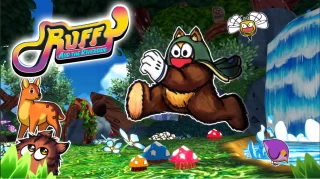You might want to sit down for this… The original mansion-exploring, zombie-slaying, Jill-sandwiching horror game, Resident Evil, was first released exactly 20 years ago in the United States today. Once a synonym for the entire survival horror genre, the Resident Evil series has seen ups, downs, thematic shifts, and extended cinematic detours over the past two decades. At its best, this franchise has produced some of the greatest horror games of all time, like Resident Evil 2 and 4, while simultaneously being sidelined by a film series that didn’t seem to understand or care about the source material at all. Similarly, some of the more recent games in the series have all but abandoned terror and tension in favor of action and cinematic flair. One thing Resident Evil certainly can’t be accused of, often to the dismay of its fans, is being afraid to try something new.
One of the more interesting facets of Resident Evil’s history, and a surprising one at that, is its enduring relationship with Nintendo. Despite Nintendo’s family-friendly image, many Resident Evil titles– including one of the series’ finest– debuted as Nintendo console exclusives. Here at Nintendo Inquirer, we’d like to celebrate our love for the grandfather of survival horror games by looking at the odd and extensive partnership between this delightfully horrific franchise and the house of Mario.
Resident Evil 2 (Nintendo 64)
Resident Evil (or Biohazard, in Japan) defined a genre and made a name for itself on the Sony PlayStation in March of 1996. The almost haphazard combination of serious-yet-hilarious dialogue, tense survivalist gameplay, and absurd logic puzzles struck a chord with gamers. It introduced the world to the nefarious Umbrella Corporation, the chill-inducing name that would half-wittingly unleash the apocalypse, and a handful characters that still frequent Resident Evil games today.
While the original Resident Evil wouldn’t make its way to a Nintendo console until 2002, its sequel, Resident Evil 2, did so in a slightly more timely fashion. Two years after its debut in January of 1998 (again on PlayStation), a heavily modified and in many ways enhanced version of RE 2 was released for Nintendo 64.
Resident Evil 2’s transfer from PlayStation’s spacious optical disc to Nintendo 64’s cramped 512mb cartridge proved to be quite a challenge. It took a staff of around 20 people from three different studios about a year to complete, but the result was a port that lived up to– and in many ways exceeded– the offerings of its PlayStation counterpart. The N64 version boasted alternate costumes, a slider to adjust gore levels, new documents to reveal additional series lore, and a variety of visual enhancements. The game’s audio was also reworked to offer higher quality music tracks and Dolby Surround support.
Despite its faithfulness and enhancements to the original version of the game and praise from critics, the Nintendo 64 version of Resident Evil 2 barely broke half a million sales worldwide. The undead horde just wasn’t quite at home on a Nintendo platform… yet.
Around this same time, another version of Resident Evil 2 was quietly in development for Game Boy Advance. Developer Raylight Studios made some amazing progress on the idea, considering the hardware limitations, but the project was ultimately cancelled. It did make for an impressive tech demo, though, if nothing else:
Resident Evil Gaiden
While we’re talking about handheld horror, there’s another early Resident Evil title that’s worth mentioning. Resident Evil Gaiden, the first Nintendo-exclusive game in the series, was released for Game Boy Color in 2002.
Shifting from dynamic cameras angles to a fixed, top-down perspective, RE Gaiden bore a closer resemblance to early Metal Gear games than to its big brothers on consoles. Combat was a bizarre blend of first person, JRPG-style encounters, and rudimentary quick time events. It was a creative way to illustrate the series’ grisly brand of action, but ultimately it couldn’t replicate it with the same quality or success. Some of Resident Evil Gaiden’s narrative ideas would reappear many years later, like its setting aboard a luxury cruise ship, but ultimately it’s an entry that has been more or less lost to time.
Resident Evil (GameCube)
The launch of the GameCube kicked off the golden age of Nintendo’s gruesome partnership with Capcom, and, some might argue, of the Resident Evil series as a whole. In early 2002, the original Resident Evil finally made it to a Nintendo console. But unlike the N64 adaptation of Resident Evil 2, the new generation of hardware allowed for a complete remake from the ground up.
The GameCube version of Resident Evil was almost more of a reboot than it was a remake. Series creator and often director Shinji Mikami spearheaded the project personally, taking advantage of GameCube’s powerful hardware to re-envision his original masterpiece.
The core gameplay and presentation of the new title remained the same, but every other element of the game was overhauled dramatically. Static backgrounds came to life with flickering candlelight, windswept grasses and swirling mists; the old mansion and its surroundings felt infinitely creepier and more immersive. The remake also took its unfortunate heroes beyond the walls of the mysterious mansion with a greatly expanded map, reworked puzzles, and an extensive new subplot that had been cut from the original game. This masterful adaptation of a young classic made a very strong case for its home on a Nintendo platform, and thankfully there was plenty more on the way.
Resident Evil 0
A mere eight months after Resident Evil’s strong GameCube debut, another Nintendo-exclusive entry in the series was released: Resident Evil 0. Adapting its newfound proficiency with the hardware, Capcom pulled the infected curtain around Spencer Mansion and Raccoon City back a bit further to the surrounding Arklay Mountains. As a prequel to the original, RE0 explored the origins of the outbreak that would eventually overtake the entire region.
Conceived alongside the original in 1995, Resident Evil 0 was initially planned as a Nintendo 64 title. As a secondary project, development on the title progressed slowly, and when it became apparent that its scope was a bit much for an N64 cartridge, the decision was made to shift it to the newly announced GameCube. This change not only alleviated any storage problems the developers were facing, but it allowed them to enhance their vision for the title in many other ways, as well.
RE0’s most novel and defining addition was the “partner zapping” system. This mechanic allowed the player to work through the game’s many combat and puzzle challenges from two unique perspectives simultaneously. The two main characters, a police officer and a medic, each brought unique abilities to the table, and direct player control could be transferred back and forth between the two on the fly. This dichotomy figured heavily into the game’s puzzles, item management and combat scenarios, and was generally received as a welcome change to the formula.
Resident Evil 4
Okay, okay, I’ve made you wait long enough; it’s time to talk about the crown jewel of the series: Resident Evil 4. Though it would go down in history as the pinnacle of the franchise, for many, RE4 first endured a long and turbulent development cycle. Numerous builds of the game spanning multiple platforms were explored. Most of these concepts were scrapped entirely, but one went on to become the first in another long-running Capcom franchise: Devil May Cry. In 2005, after at least five years in development, the fourth proper Resident Evil game arrived exclusively for Nintendo’s GameCube, and brought its partnership with Capcom to its apex.
Resident Evil 4 felt like the first true evolution in the series since its inception. Breaking away from the fixed camera angles and binary weapon controls, RE4’s rural European setting was conveyed in fully rendered 3D environments. The prototypical zombies were replaced by mentally deranged, yet coherent villagers, possessed to kill by some otherworldly force. Something about being yelled at in a foreign language before a mob of bloodthirsty townspeople descends upon you made for an entirely new brand of terror that was nowhere to be found in Spencer Mansion or Raccoon City.
The shift to a dynamic, over-the-shoulder camera added some much needed depth to Resident Evil’s gunplay. Rather than two gun positions– up and down– Resident Evil 4 allowed for full aiming control, allowing for precise and strategic targeting of appendages, and the occasional tentacle. These mechanics would be carried into every future entry in the series, and in some ways marked the transition to a more action-oriented experience; but RE4 walked a near-perfect balance between faster, deeper gameplay and the series’ signature brand of tension.
Though Shinji Mikami went on record as saying that Resident Evil 4 would remain a GameCube-exclusive title, it eventually jumped ship to PlayStation 2. Still, Nintendo will always have first bragging rights when it comes to RE4, and there’s also this to consider:
Wii too
Admittedly, GameCube’s trio of Resident Evil exclusives was a near-impossible act to follow, but the Wii generation did see its own, unique brand of Resident Evil support from Capcom. Unfortunately, these titles felt sorely underwhelming by comparison.
Jumping on the motion control bandwagon and taking superficial advantage of the Wii’s unique attributes, Capcom co-developed a series of on-rails shooters set in existing plots in the Resident Evil universe. Resident Evil: The Umbrella Chronicles and The Darkside Chronicles removed most of the series’ tension, puzzles and ambience in favor of an arcade-style shooting gallery.
The pair of titles contained plenty of fan service in the form of plot exposé and character cameos, but ultimately felt like they were shoehorned onto the console simply because of its massive install base.
A few more portable exclusives
Resident Evil’s portable incarnations didn’t end with Game Boy; a handful of exclusives titles appeared on Nintendo DS and 3DS systems as well.
In 2006, yet another remake of the original Resident Evil appeared on Nintendo DS. Going by the title Resident Evil DS– or Deadly Silence– the port included “Classic” and “Rebirth” modes, a preserved take on the original and a more difficult DS-tuned mode, respectively. Deadly Silence was the first DS title to carry an M-rating, and used the secondary touch screen in a variety of interesting ways; like stylus controlled knife battles and a CPR minigame that utilized the system’s built-in microphone.
The 3DS saw a fair share of Resident Evil’s zombie goodness in the form of two exclusive titles of its own. Resident Evil: The Mercenaries 3D was released just a few months after the launch of the 3DS, and adapted the look and style of the recently released Resident Evil 5. Lacking any real story or adventure of its own, Mercenaries was a repackaging of the arena-based Mercenary mode from Resident Evil 4 and 5. While it didn’t make for a very deep or compelling experience, it was one of the better early technical showpieces in the 3DS library.
A much better, and deeper, Resident Evil experience came to the 3DS a few years later in the form of Resident Evil: Revelations. Revelations was a return to form for the series, thematically. Revisiting the derelict cruise ship setting from RE Gaiden, it cut back on the action-heavy cinematics and honed in on terror through isolation. This late-series Resident Evil gem also set a standard for what the 3DS is capable of, visually, and remains one of the best looking games on the system to date.
What’s next?
At this point, we have no reason to expect any special Resident Evil treatment on Nintendo’s current or upcoming consoles. Capcom, like many other major third parties, seem to approach Nintendo with a certain amount of trepidation these days.
It’s hard to say if this is because of sales numbers, Nintendo’s image or difficult corporate relations. Looking back at this extremely long list of titles, though, many of which are or were Nintendo exclusives, I can’t help but be hopeful for what might come next. Sure, many of the games we’ve looked at have gone on to see HD remakes, updates and ports to other platforms, but some of my most cherished memories with Resident Evil will always be Nintendo experiences.
Happy 20th birthday, Resident Evil, and here’s to a long and horrific future!
Source credits:
Resident Evil 4 box image (seen in thumbnail).
Resident Evil 2 (N64) box image.
Resident Evil Gaiden box image.
Arklay Mountains screen shot.
Resident Evil DS screen shot.
Resident Evil: Revelations box image.












